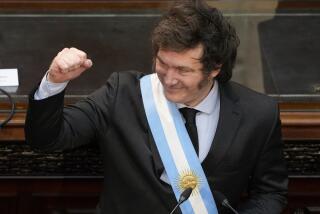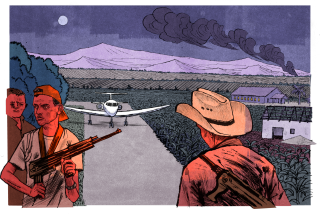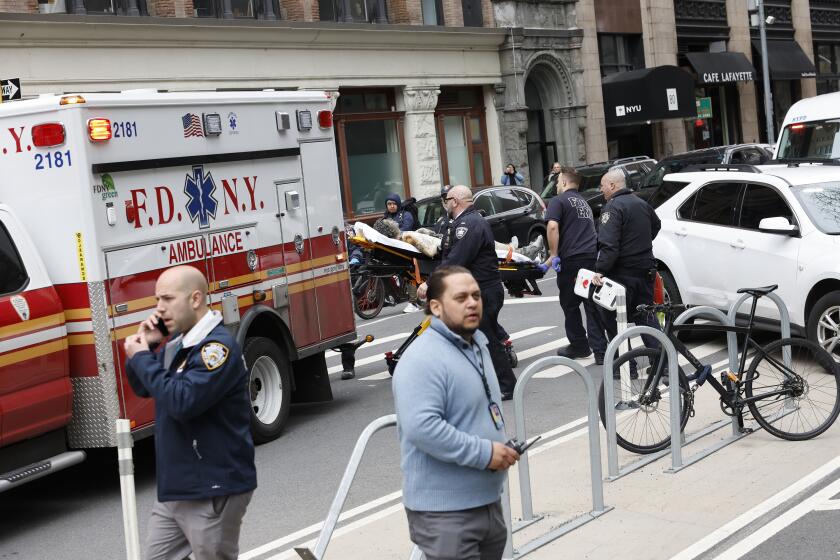From the archives: Colombia Drug Lords Find Fugitive Life Erodes Power
BOGOTA, Colombia -- Pablo Escobar and Gonzalo Rodriguez Gacha have joined the notorious ranks of Billy the Kid and Al Capone. After years on the rampage, the two Colombian drug lords seem bigger than life and as bad as bandits come.
Forbes magazine estimates the pair’s wealth in the billions of dollars. In addition to buying the compliance of countless Colombian officials, they are known to finance paramilitary platoons in rural areas and squads of hired killers in the cities. They have been accused of ordering hundreds of killings, including those of government ministers, presidential candidates, police officials, judges and journalists.
Escobar, 39, and Rodriguez Gacha, 42, have come close to cowing a nation of 30 million people with bullets and bribes. The ruthless methods that made them infamous have even added a new word to Colombia’s lexicon of violence: narcoterrorismo .
In the last two months, however, the dreaded cartel barons have lost much of the fearsome power that their guns and money gave them. Beleaguered by government security forces, the two have suspended most of their drug operations in Colombia to concentrate on avoiding capture, Colombian and American officials say.
Their trafficking organization, known as the Medellin cartel, has been hit hard by an onslaught of government raids and the arrests of key associates. Escobar and Rodriguez Gacha are said to move from hide-out to hide-out, staying just a jump ahead of investigators and security forces.
“Reportedly, they came very close to being captured several times and managed to escape,” a senior American official said the other day.
In an attempt to intimidate the society and undermine the government’s declared goal of seizing them for extradition to the United States, the narcoterrorists are pressing a campaign of dynamite bombings. At least 150 bombs, most of them blamed on Escobar and Rodriguez Gacha, have exploded during the last two months, killing a total of 10 people.
In the deadliest blast so far, more than 100 pounds of dynamite set off in a parked car Monday killed four employees of the pro-government Vanguardia Liberal newspaper in Bucaramanga, 190 miles north of Bogota.
The official anti-drug blitz has concentrated on Escobar, Rodriguez Gacha and their associates rather than other trafficking groups.
“It is a war against Escobar and (Rodriguez) Gacha, obviously,” said Juan Carlos Pastrana, editor of the Bogota newspaper La Prensa. “I haven’t seen any war against the others.”
Security forces have raided scores of ranches, urban apartments, offices and other properties. Authorities have seized hundreds of airplanes and automobiles, and large stockpiles of weapons and drugs.
Not since 1984, when the Medellin cartel was accused of assassinating Colombia’s justice minister, has the pressure to capture Escobar and Rodriguez Gacha been so strong. That year, the two took temporary refuge in neighboring Panama, but now they are known to be hiding in Colombia.
The government has issued “wanted” posters bearing photos of the two men and offering a $250,000 reward for information leading to their arrest.
Authorities have announced the arrests of nearly a dozen key members of Escobar’s and Rodriguez Gacha’s organizations, including Jose Rafael Abello, identified by police as the No. 4 man in the Medellin cartel. Four other accused Colombian traffickers have been sent to the United States for trial since President Virgilio Barco Vargas, using his powers under a longstanding state of siege, issued a decree Aug. 18 permitting extradition
Still, the most important Colombian traffickers remain at large. They include Jorge Luis Ochoa, another leader in the Medellin-based network, and Gilberto Rodriguez Orejuela and Jose Santacruz Londono, reputedly the top leaders of a rival cartel based in the city of Cali.
The most-wanted bandits of all are Escobar and Rodriguez Gacha; no other traffickers have come close to combining cunning, greed and open violence with such frightening force as those two.
“Their power arises from the fact that they have the biggest enterprises, the richest and the most brutal,” said the senior U.S. official, who asked not to be further identified.
“They are very mobile,” the official added. “These guys have been on the lam now for some time. Their operations, their life style, have been geared to keeping moving.”
Because of the official blitz, Colombian traffickers have “closed down large portions of their cocaine production,” the American official said. “They are transiting very little cocaine out of Colombia.” As a result, Escobar and Rodriguez Gacha can keep a lower profile.
“When they close down, then it becomes much more difficult to find them because they are not doing their usual things.” he said. “They are not out taking care of their trafficking empire.”
At the same time, however, the confiscation of many ranches and offices, communications equipment and other property belonging to the two has limited their resources and hiding places, said a high Colombian police official.
“They are feeling seriously wounded,” he said. The official, who asked to remain anonymous for security reasons, confirmed that Escobar and Rodriguez Gacha have evaded capture in more than one close call recently.
“Those operations generally fail because there are so many people who are their friends,” he said. But he added that the two are starting to lose the collaboration of Colombians who once aided them out of fear or friendship, especially in rural areas where they hide.
“They are now more alone,” the official said. “They are disoriented and scared. They see that the authorities are really after them, and they see that money no longer works.”
He speculated that Escobar and Rodriguez Gacha must be getting nervous, more prone to make mistakes.
“We know more or less in what area they are hiding,” he said. “We are looking for the right moment and the right opportunity.”
Meanwhile, he said, cocaine traffic out of Colombia has been reduced to “small shipments” by lesser-known traffickers. He also said that Escobar, Rodriguez Gacha and other drug lords are stashing their cocaine stocks, which are appreciating in value as the reduced flow pushes up prices in the United States.
“They might be producing, but very little, maybe 20%,” the official said.
Both this official and the American disagreed with speculation from U.S. law enforcement officers that large cargoes of cocaine recently seized, such as the 19.8 tons discovered Sept. 29 in a Sylmar warehouse, had been shipped since the Colombian crackdown.
An officer in another police agency said the continuing government campaign is digging up a growing body of information, which is being collected and constantly analyzed in computers. Greater knowledge about the operations of Escobar and Rodriguez Gacha is putting them in an increasingly vulnerable position and giving authorities a moral boost, according to the official.
“The intelligence is producing more and more results every day,” he said. “We are stronger today, much more capable. The personnel is much more eager.”
The Medellin cartel is not a true cartel in the business sense, but rather a loose association of drug makers, distributors, transportation specialists and others. Although Escobar is regarded as the richest and most powerful of them all, there is no structure with formal hierarchy and chains of command.
Many analysts say the trafficking organizations are more of a Mafia than a cartel. In fact, Escobar is sometimes called “El Padrino,” Spanish for “the Godfather.”
Short and pudgy, with curly black hair and hazel eyes, he went to high school in a blue-collar district of Medellin, now a city of 2 million people. His first known business venture was stealing gravestones so that they could be resurfaced and resold.
Later he became a car thief and a bodyguard for an electronics smuggler. He made a quick $100,000 in the early 1970s by kidnaping and ransoming a Medellin executive.
In 1976, police arrested him for possession of 39 pounds of cocaine. Typically, Escobar never went to trial. A year after the bust, gunmen killed the two arresting officers.
By then, Escobar’s cocaine-smuggling gang was known on the streets of Medellin as Los Pablos. Business boomed in the late 1970s, and by the early 1980s, the newly rich kingpin was investing heavily in real estate, including an $8-million apartment complex in Florida.
His $60-million Colombian ranch, called Napoles, boasted a spacious zoo with African animals and a bullet-riddled sedan that was said to have belonged to John Dillinger or Al Capone.
Escobar won election as an alternate member of the Colombian Congress in 1982, filling in on the floor when the full member was absent. In Medellin, he sought respectability with his own radio show, newspaper and a civic program called “Medellin Without Slums.” In his most famous act of philanthropy, he financed Barrio Pablo Escobar, a hillside housing development for former slum dwellers.
But those who are familiar with Escobar’s business methods were undeceived by the Mr. Nice Guy image.
“More than anybody in the Medellin cartel, Escobar was known as an enforcer,” wrote Miami Herald reporter Guy Gugliotta in “Kings of Cocaine,” an authoritative 1989 book on the cartel. “He never forgot an insult; he held grudges; he took revenge.”
Among killings Escobar has been charged with or accused of are the assassinations of Justice Minister Rodrigo Lara Bonilla in April, 1984; Superior Court Judge Tulio Castro Gil in July, 1985; former anti-narcotics police Col. Jaime Ramirez in November, 1986; Editor-in-Chief Guillermo Cano of the Bogota newspaper El Espectador in December, 1986, and Atty. Gen. Carlos Mauro Hoyos in January, 1988.
Escobar’s partner, Rodriguez Gacha, is equally ruthless and vindictive. He has been charged in some of the same killings and in others, including the assassination of former leftist presidential candidate Jaime Pardo Leal in October, 1987. Both Escobar and Rodriguez Gacha are implicated in the slaying of presidential candidate Luis Carlos Galan on Aug. 18, the act that prompted President Barco to launch his campaign.
And both have been charged with issuing orders to kill dozens of rural workers in massacres by “paramilitary” commandos. Escobar and Rodriguez Gacha, who own numerous ranches, are believed to have financed dozens of armed groups that originally were formed to protect ranchers against guerrillas but became tools for narcoterrorism.
Rodriguez Gacha also has marshaled groups of gunmen this year in a violent campaign to take over rich emerald mines in a mountainous area north of Bogota. The so-called “Emerald War” began in February when gunmen killed emerald tycoon Gilberto Molina, who was once known as Rodriguez Gacha’s friend and mentor, along with 16 other persons at a party in Molina’s home.
Rodriguez Gacha’s hometown is Pacho, on the southern edge of the emerald fields. He grew up poor, and like many Colombian campesinos , his formal education did not go beyond grade school.
His friendly country manners and his fabulous financial success made him a popular celebrity for miles around. In the town of La Dorada, west of Pacho, Rodriguez Gacha celebrated his birthday in May, 1986, with a three-day party that has became famous throughout Colombia.
Escobar, Ochoa and other drug lords attended the public bash, highlighted by a horse parade through the town, according to press reports. Even though Rodriguez Gacha had more than 100 bodyguards on hand for the occasion, a local police commander provided officers for security.
Known as “El Mexicano” because of his fascination with Mexico, Rodriguez Gacha owns a string of ranches in the Pacho area with Mexican names such as Cuernavaca, Chihuahua, Sonora and Mazatlan.
“He ran the Pacho area,” an intelligence official told The Times in September. In a later interview, the same official said security forces were about to close in on Rodriguez Gacha more than two months ago at a discotheque he owns in Pacho, but residents tipped him off in time to escape.
“He had the sympathy of the majority of the town,” the official said.
His friends also apparently included military officers. A 1988 investigation of the kingpin’s telephone bills in Pacho revealed calls to several military headquarters.
In recent weeks, Escobar and Rodriguez Gacha, apparently weary of their life on the run, have issued repeated messages calling for a “dialogue” with authorities to negotiate a peace settlement.
“This is what I propose,” Escobar was quoted as saying in an interview published in late August by the French newspaper Liberation. “We will give the government all of the confiscated properties and also the airplanes. Our only desire is to integrate into society, legal society, but it is the government that doesn’t want it.”
Liberation said he added: “If total war must be waged, we will do it until the end.”
Also in late August, Rodriguez Gacha told a Colombian television journalist by telephone that the traffickers would give up their drug business in exchange for amnesty.
“We are fighting, trying to be heard so that they will dialogue with us,” Rodriguez Gacha said. Authorities barred Colombian media from airing the taped interview.
In late September, both Escobar and Rodriguez Gacha renewed their proposals for a dialogue in telephone calls to Norberto Morales, chairman of the Colombian House of Representatives. Morales said that they both offered to “put an end to the war and bring several million dollars into the country.”
Barco vows that he will not relent in his “crusade” against traffickers, but Colombian political scientist Rodrigo Losada says the narcoterrorists are also unlikely to relent.
“We are going down a blind alley, in a sense,” Losada said. “I don’t believe we have the means to guarantee that we will free ourselves of this problem. It is a very terrible situation.”
Losada said he fears that Escobar and Rodriguez Gacha will escalate their terror campaign, targeting important political figures for more of what the press here describes as “magnicides.”
“If the narcoterrorism stays at the current level, the country can tolerate that for a long time,” said Losada, a researcher with the Bogota think tank named Instituto SER. “But if the narcotraficantes are able to strike very strong blows, such as killing a former president, the government might give in.”
More to Read
Start your day right
Sign up for Essential California for news, features and recommendations from the L.A. Times and beyond in your inbox six days a week.
You may occasionally receive promotional content from the Los Angeles Times.






